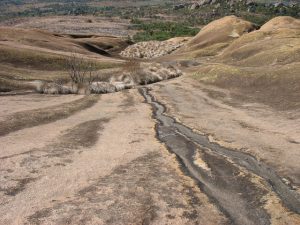When we moved back from the farm, the next year there was a drought. That was 1947. That one was terrible. You know, there was no food. We couldn’t go anywhere to find mealie meal or find maize. But there were some people in the village who had mealie meal, and they could give us a little bit. And my grandmother used to go and ask for sadza, the sadza left over from the day before. She used to say, “I will give it to my chickens.” And she puts it in a cloth hanging on her back. And when she comes home, she has to take off all the hard bits on the outside. Then she puts what is left in a pot, boils it, gives it to us, and we eat.
And I remember one day, she went in the bush and collected some fiber from the bark of a tree, and rolled it. We didn’t have vegetables to eat; we had sadza, but no vegetables. So she tied knots in the bark fiber, and put them inside the plate, and added water and salt. So you could take this fiber, and hold it in your left hand. When you want to eat, you take sadza and dip it in the water, and eat it. This bark fiber, it’s like meat. You know, you won’t eat it, but holding it helps you to eat sadza. So we could eat sadza that way.
And the District Administrator sent some policemen who used to go into the villages and tell people not to eat sadza with okra, sour milk, or fish. Because if you eat sadza with those things there, then you eat a lot. So they said, “You will finish the mealie meal!” They used to send messengers to see if people were doing so.
But where we lived, we could catch so many fish. So we were relying on fish. You know, we couldn’t help it. They were saying, “This year there’s a drought, and people must be very careful not to eat okra, not to eat fish.” But we had so many fish, and that was the meat that we could use to eat. And that’s what we were using as food, fish and a little bit of sadza.
And there is bemhapemha, a type of honey available during the hot season, which comes from the leaves of trees. You would see it coating the leaves. So we would collect those leaves, and take a large clay pot, and fill it halfway with water. And we would take the leaves and soak them, removing them and adding more leaves, and placing them inside. And the pot fills up with that honey, which is very, very white and clean. When you drink that honey, you can spend the rest of the day drinking only water, because you will feel full.
When it didn’t rain, some people used to take a type of grass called ruga, which grows in the veld. They would dig it up, and prepare it, and bring it back and grind it, and make it into meal. Then they would eat sadza. Now, that grass can no longer be found, because people are living in all of those places, where it used to grow.
Even many of the wild fruits that used to be available are now scarce. There in Guruve, when there were no rains, we used to eat so many different wild fruits. Among them, there was a tree that used to produce something we called umanye, which you could pick off and eat. They came right out of the wood. There are very small ones that resemble sorghum seeds, but they are black. If you eat them, they taste so sweet, like honey. That is what kept people alive; that is what we ate.

